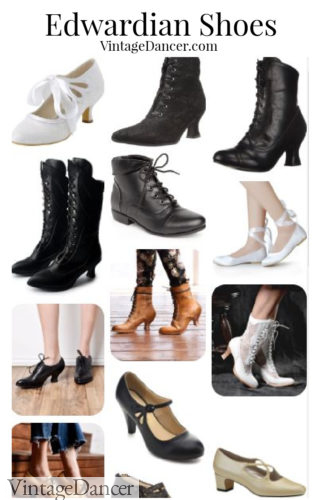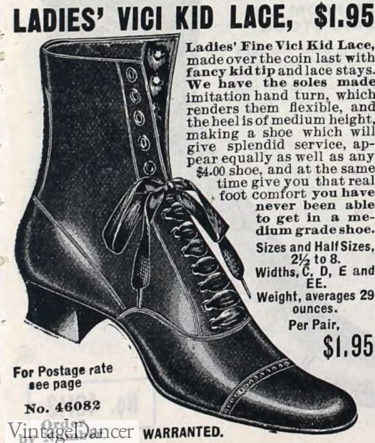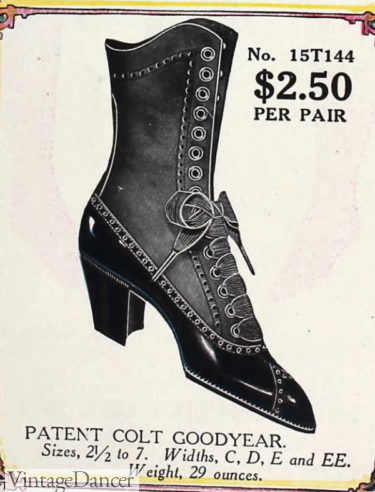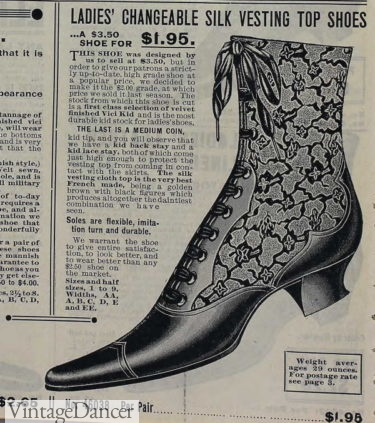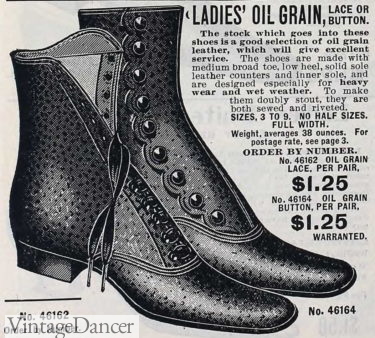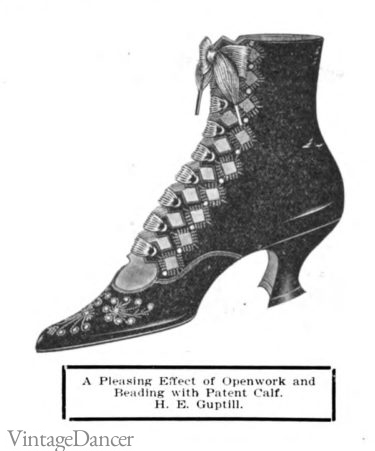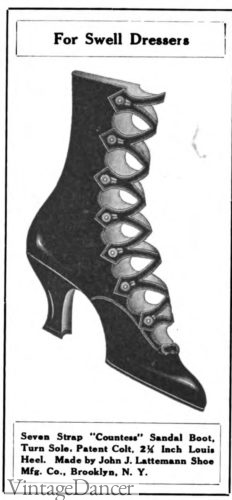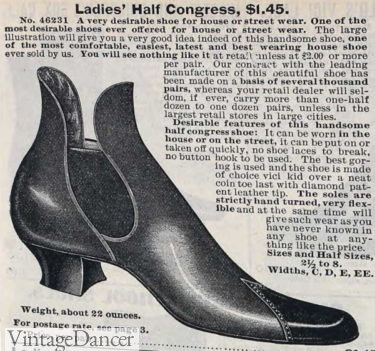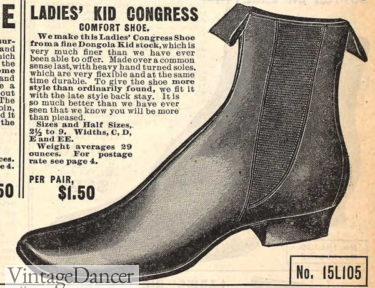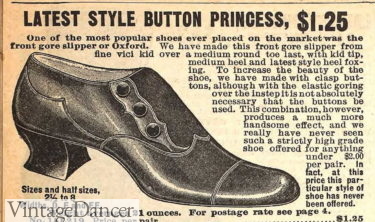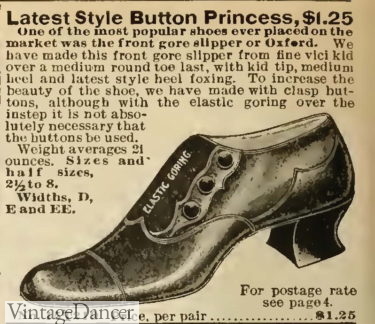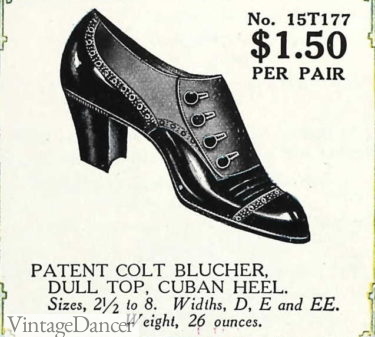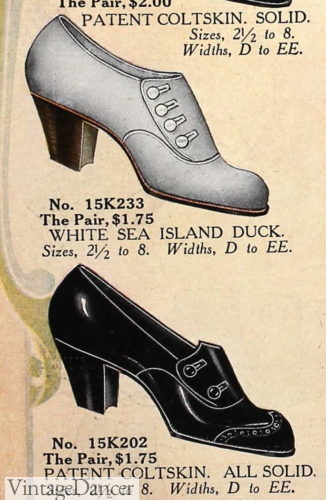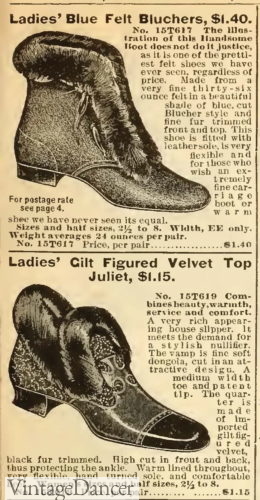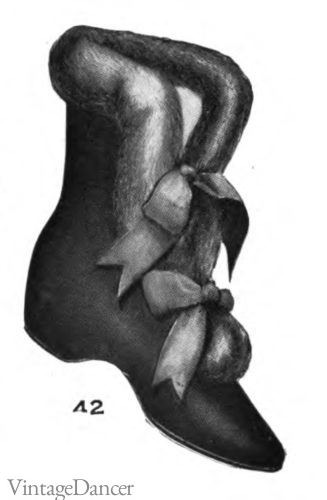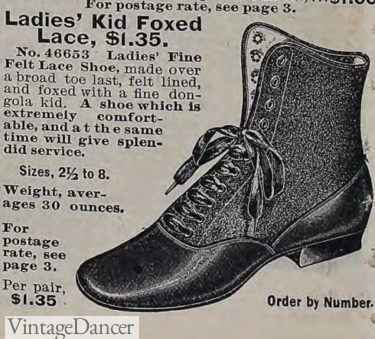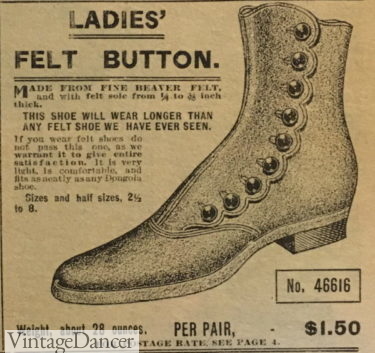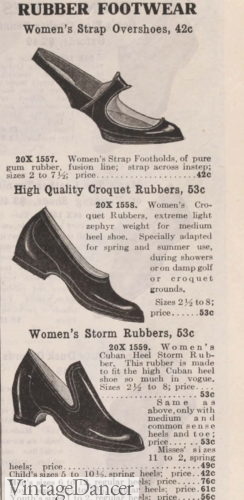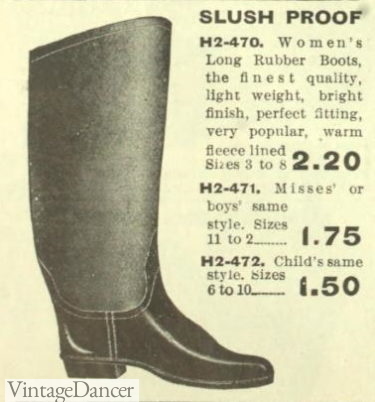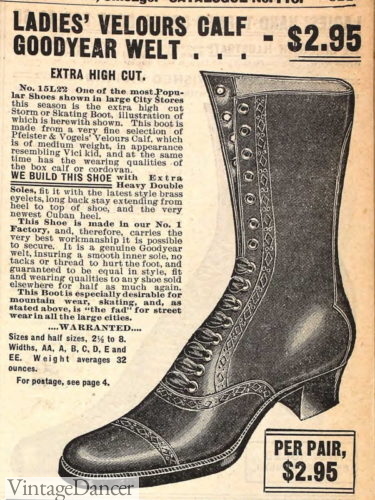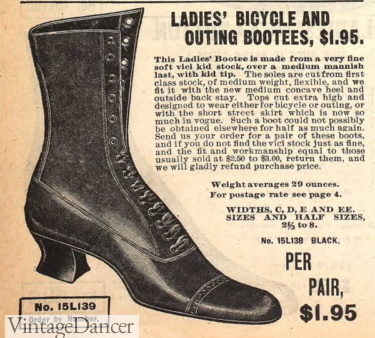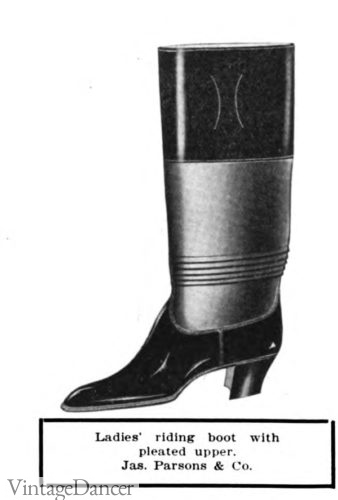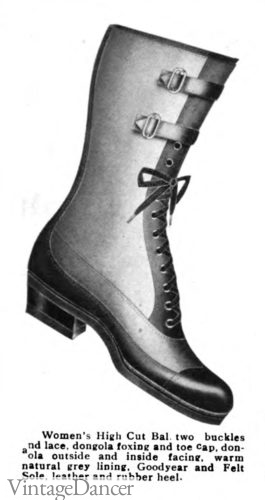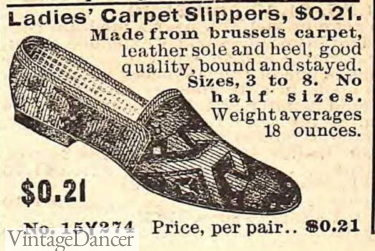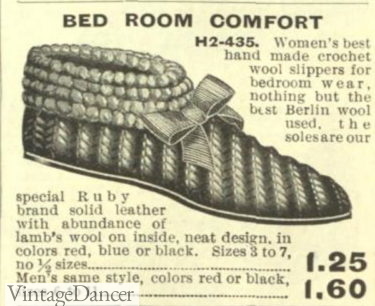The Edwardian era roughly spans the late 1890s, 1900s and early 1910s. It was the time between the ornate Victorian era and the dazzling Roaring Twenties. Women’s Edwardian shoes saw more diversity as the years progressed — no longer were women in boots all day long with a growing choice of lower heel Oxfords, pumps, and even flats and sneakers.
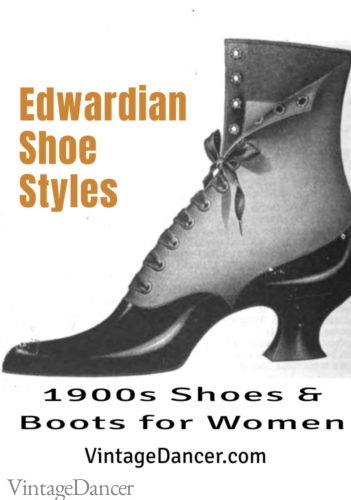
Between the recent Titanic anniversary and the fan favorite Downton Abbey TV show, there has been a renewed interest in this era, both for reenactors and themed event attendees, as well as those following the CottageCore trend.
As I was browsing for new Edwardian styles shoes for my Edwardian Style boots and Shoes shopping page, I went back to my vintage catalogs to see just what styles of Edwardian shoes were popular for women. I found a few Edwardian boots and shoe styles that surprised me. Do these shoes surprise you too?
Shop Edwardian Style Boots and shoe here
Be sure to also read about Victorian era shoes as as well as 1912 (Titanic era) shoes.
Edwardian Boots
Lace Up Boots
Just like the Victorian era before, Edwardian women continued to wear lace up or button up tall boots. They usually came to mid-calf or a tad lower and laced all the way up the shaft.
- 1900 kid skin basic lace up boot
- 1910 lace up boots in black patenet and matte kid leather
Leathers were soft kid skin, calf skin, colt skin (horse) or tough kangaroo skin. Most were a smooth body but could also be pebbled or oiled. Black was the primary choice until natural tan leather became trendy around 1905.
Two tone combinations emerged at the same time, combining two types of leather (patent and kid, suede and smooth leather, etc), two shades of color (brown and black or grey and black, etc) or leather with fabric. The foot was always a black or dark color with a lighter color upper.
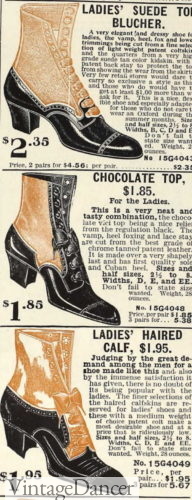
1907 tan and black leather boots
Fabric top (silk, velvet), duck (canvas) or wool felt were the most flexible boots around the calf. Silk fabric colors were usually dark brown or black, dark blue or deep burgundy. The prints resembled tapestry, damask, brocade and scrollwork.
Most laces were wide silk knit ribbon while fancy dress boots may have been tied with flat silk ribbon that tied in a fluffy bow.
- 1900 golden brown and black silk top boots
- 1900 oil grain textured boots
Around 1909 an open work (cutouts) or strappy boot came into vogue. They incorporated the multiple straps now in style on ladies dress shoes. They were very pretty, very high fashion, usually made of dyed leather, velvet, silk or patent leather. These Sandal Boots are sometimes referred to as Tango boots, although those laced up with ribbon instead of straps.
- 1904 open work strappy boots
- 9 strap boots
The cuban heel (squared), spring heel (very short), and Luis heel (curved French heel) were made in both dress and casual boots and shoes. The cuban heel was sturdy and more “mannish” while the Louis heel was pretty and lady like.
Around 1910 the military heel (squared outer with inner curve) became the latest sturdy heel shape.
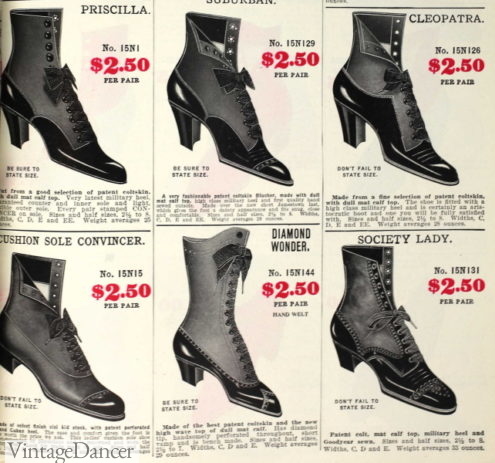
1909 ladies lace up boots
Toe shapes came in the very narrow and long coin toe which was as wide as a silver dollar. It was elegant but less than practical to walk in. A women with a small foot was considered to be of a high class with good breeding. Women purchased boots made for their feet but also elongated toes, raised arches, and perched on taller heels.
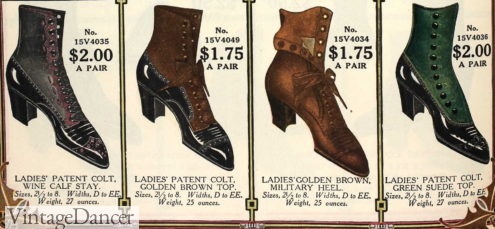
1910 colored top boots with military heels
There was shorter rounded broad toe, shaped almond and slightly squared toes too. The broader the toe box the more comfortable and practical the boot. Working classes, the elderly and country women had little need for fancy boots- they choose boots that were low heeled and wide toed.
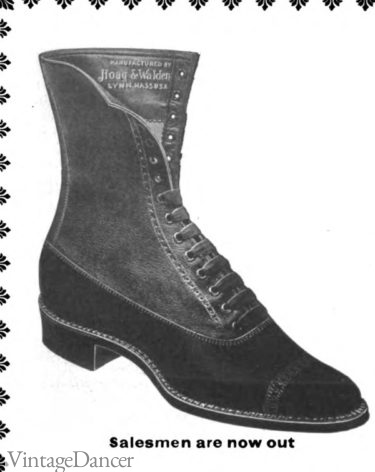
1901 ladies comfort boot with low heel and broad toe
Edwardian Button Boots
Besides lace up boots there were button up Edwardian boots. Button up boots featured a curved or scalloped row of pearl buttons and eyes that fastened on the sides. A button hook was needing to pull the buttons through the eyes. Buttoning them by hand was possible but painful on the fingers.
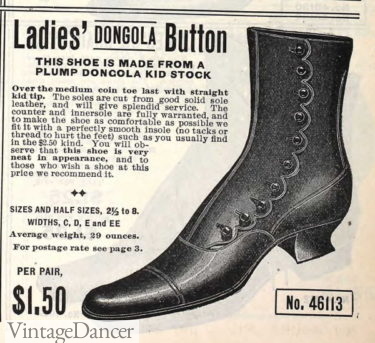
1899 Scallop Button Boots
They were considered more dressy than lace up boots. They fit close to the foot without much give acting like a corset for the feet.
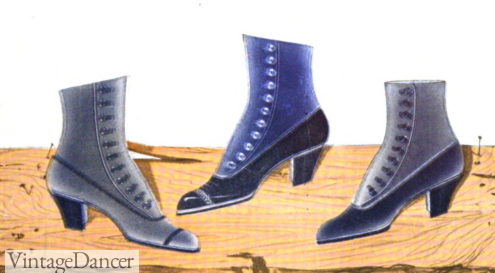
1909 button boots
Later styles included two tone button boots of black and white/ivory. All white/ivory boots were popular with summer dresses. Other colors such as grey, red, green, blue and light tan became trendy in the 1910s.
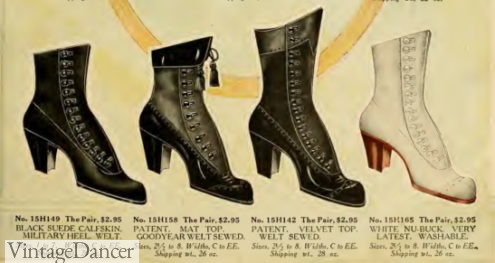
1912 button boots with curved edge, unique cuffs
Chelsea Boots
The pull-on Congress boot is an early style of the Chelsea boot. It had one or two elastic panels on the sides and pull tabs on the front and back. A half congress boot only had elastic panels around the ankles.
The Congress boot was easy to slip on and off, unlike lace or button boots. They were popular as a home or garden boot, as well as for the elderly. Most were very plain but fancier version had interesting details and French heels.
- 1900 half congress boots
- 1901 full Congress boots
Edwardian Dress Shoes
In the summer, boots were too warm to wear. Ladies turned to lighter dress slippers and strappy low heel pumps for both home and street wear. These Edwardian heels could be made of kid leather, patent leather, suede, velvet, or silk/satin.
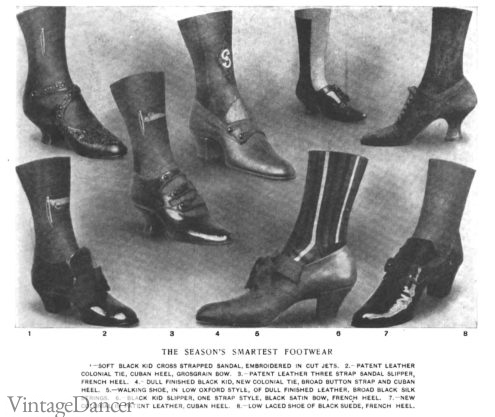
1903 dress shoes trends
Shoe that were embellished in pretty jet beads, lace, and embroidery over the straps and toe box could be fancy enough for partywear. Simpler patent leather or matte kid leather made them practical as informal or semi dress shoes.
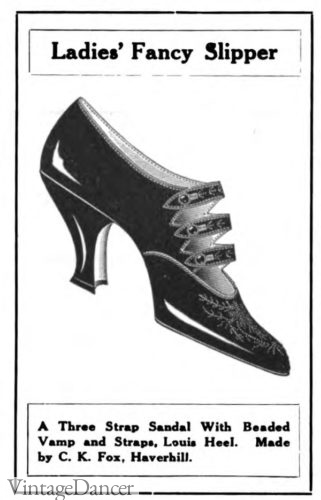
1909 beaded 3 strap slipper
Edwardian dress shoes came in serval variations: strap shoes, the princess shoe, and the colonial pump. Oxfords with a Louis heel and ribbon laces were also included in this dress shoe category. Mor eon those in the next section.
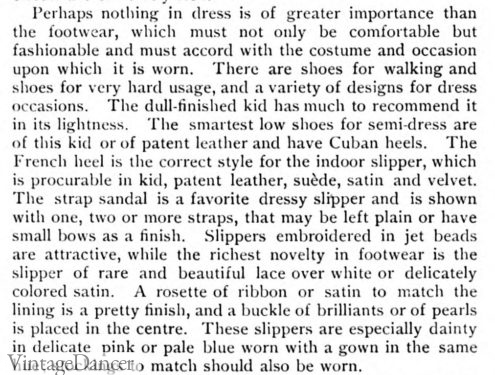
1903 notes about footwear trends in Delineator
Mary Jane Shoes
The strap sandal was the most popular Edwardian dressy shoe. Straps buttoned across the vamp in one to five narrow straps. Some straps crossed in the X pattern while most went straight over. A few pretty shoes tied with a ribbon bow on the top instead of buttons on the side.

1901 single strap heels, very simple
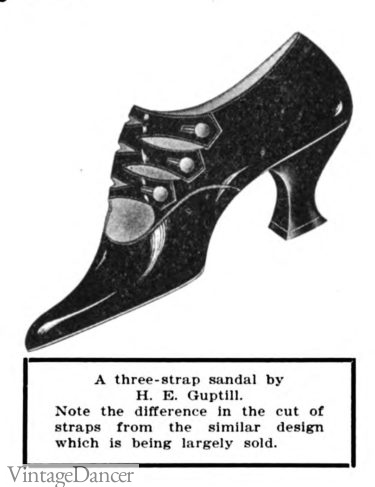
3 strap heels
50 years later the strap sandal or strap pump would be renamed Mary Jane shoes, not just for children’s, but women’s footwear, although the first use of the name Mary Jane was used in Buster Brown children’s shoes advertising in 1904.
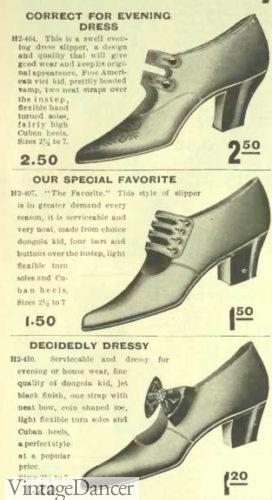
1909 multi strap shoes and a single bow tie strap
Edwardian Mary Jane or strap sandal shoes came in the sturdy Cuban heel shape for home and street or the dainty louis for pretty party dresses. Colors were black, brown, white and two tone combinations. Some were decorated with a bow on the toe or strap and embellished with beads across the toe.
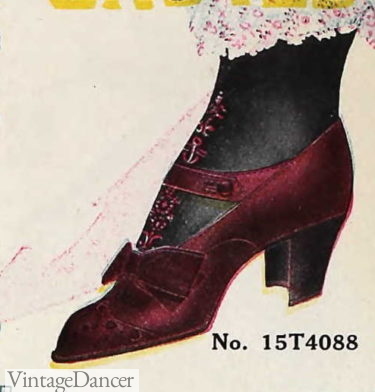
1910 velvet strap shoes with bow
Princess Shoes
The gored shoe or Princess shoe is an unusual one for the Edwardian era. Instead of narrow straps, a wide piece of elastic goring covered the vamp and buttoned to the outer side. The stretch of the elastic made them more comfortable to wear on the streets and countryside.
Like boots they needed a button hook to fasten the buttons in the eyes or they were made of clasp buttons (snap button) which were much easier to snap into place.
- 1901 gored shoes
- 1902 gored shoes
- 1910 leather princess shoes
- 1912 princess shoes in white duck (canvas) and patent leather
Button top princess shoes also existed without the elastic goring. Instead, matching leather was used for the button over piece. They were somewhat of a stylish cross between a ladies boot and an oxford slipper.
Additionally the princess shoes added a side buckle (monk strap) around 1910. They were advertised as being trendy with college age girls.
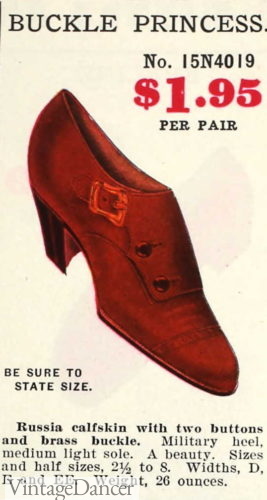
1909 buckle princess shoes
The Colonial Pump
The colonial pump was a popular Edwardian dress shoe. The defining characteristic was the buckle (or faux buckled look) and large tongue placed low on the vamp /above the toe box. They resembled shoes last seen in the 18th century.
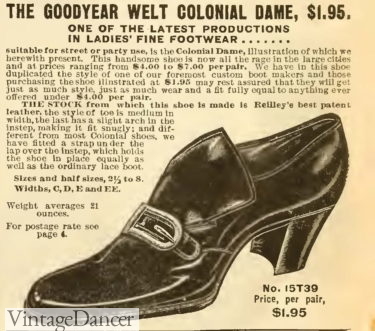
1902 colonial shoe
Colonial pumps in black patent leather and silver buckles seemed to be the most popular. They were shoes worn to stand out, not hide under long dresses. They were popular semi dress and evening shoes for several decades.
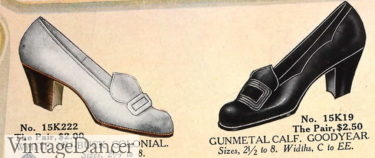
1912 colonial pumps and white duck or gunmetal leather
Shoe buckles were jewelry, enameled, pearl or leather. Ovals and rectangles were the primary shapes. Changing buckles could easily dress up or down a pair of Colonial shoes.
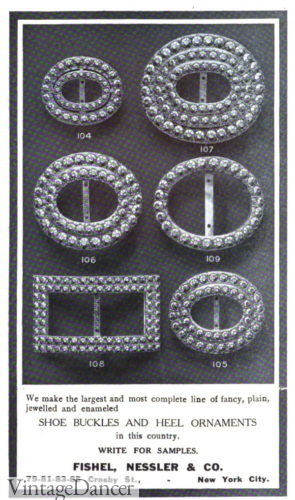
1909 shoe buckles
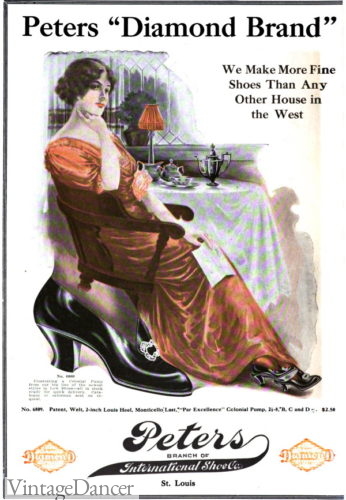
1914 patent leather colonial pump
Edwardian Shoes: Oxfords
Besides dress slippers, the Oxford shoe was an Edwardian shoe era favorite. Borrowed from menswear, the lace up oxford shoes was as practical as a boot but low cut and breathable for semi dress and casual attire.
Oxford shoes were not worn with fancy dresses but suitable to wear with suits, skirt/blouse separates, house dresses and sportswear.

1902 oxford shoes
Heel heights were fairly low to almost flat. They could be French heels, Cuban, heels or military heels with narrow toes to wide rounded toes. Cap toes and broguing were common decorations. Laces could be silk knit or flat grosgrain ribbon.
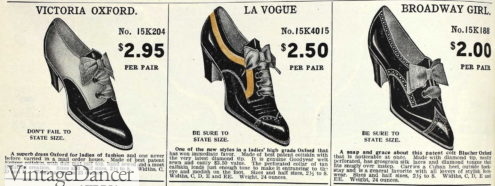
1908 two tone oxford shoes
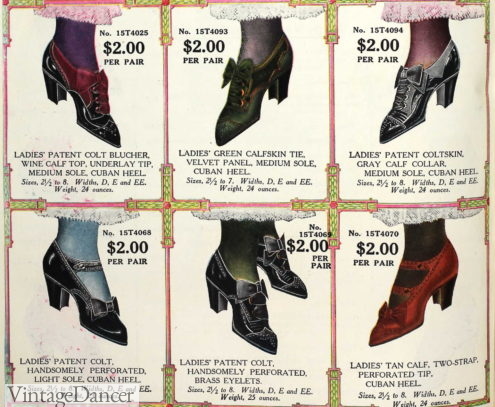
1910 ladies low cut shoes and oxfords
Oxford shoe colors were much more varied than boots and dress shoes. White with black, tan and black, grey and black were mixed as well as different leather finishes and occasionally fabrics. White oxfords were trendy in summer and two tone black/and white were common with sportswear.
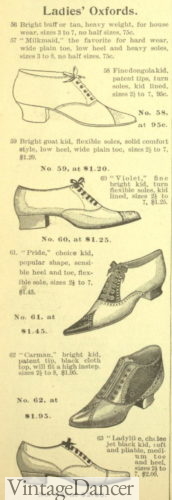
1899 oxford shoes
A very low heel Oxford was a working class woman’s shoe as well as sports shoe. It was the most comfortable and easiest to clean shoe of the group, and affordable. With a nearly flat smooth leather sole their were also “quiet” shoes that house maids could wear without being heard moving about.
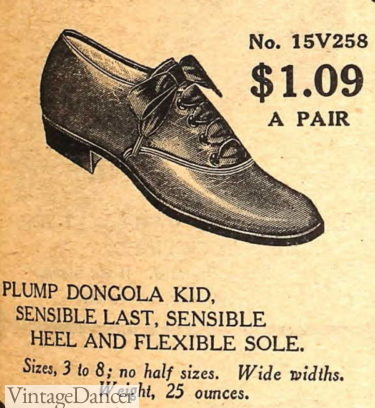
A plain oxford shoe for house work
Edwardian Slippers and Heels for Evenings
Edwardian slippers were evening shoes for dinner, dancing and weddings. Many dressy shoes could be worn in the evenings when embellished with beads, bows, rosettes or made in silk, damask or lace covered satin.
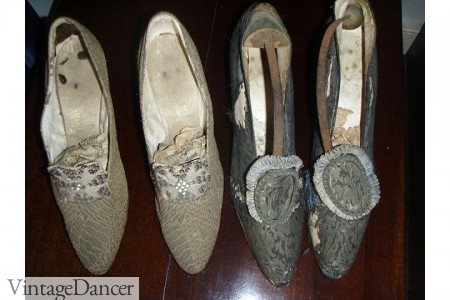
Edwardian colonial style pumps
Edwardian shoes that were never appropriate for evenings were boots, oxfords, and house slippers (even though some look very similar.)
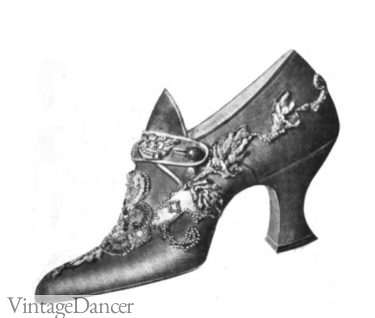
1903 fancy dress or evening shoes in pink satin
A simple fancy shoe was the classic slip on pump appropriate names “slippers.” Without a strap or lacing they were only worn for standing occasions. They did not do well for dancing or extended walking although I am sure some women did so just fine.
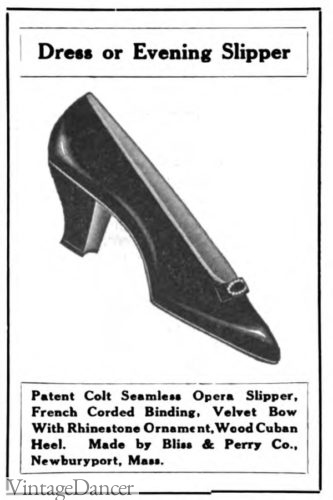
1909 simple evening slippers
Wealthy women had shoes handmade to match their ballgowns, while middle classes wore black or white leather shoes.
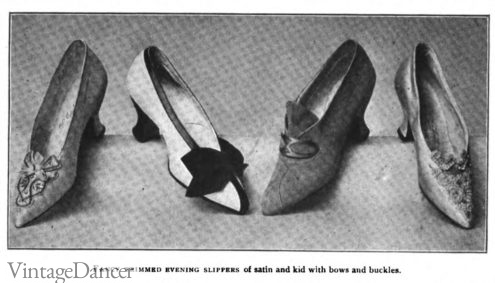
1908 custom evening shoes
Just like today’s pumps, they were slip-in style with pretty toe box decorations. A pom pom, shoe clip, big bow, flat bow, buckle or sparkling ornament of beads on the top added something special to the shoe, transforming it from day to night.
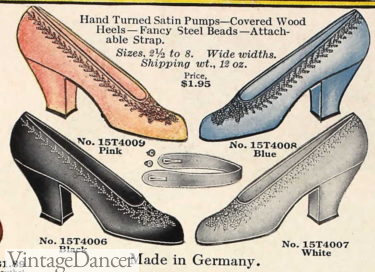
1914 satin evening heels decorated with steel beads sold with optional strap
Another common style was the Mary Jane with a single strap across the vamp that ended with a button made of pearl, plastic, bone, mother of pearl, metal or crystal. These were better for dancing.
See these silk evening pumps from 1890-1900 and ivory 1910 evening pumps at the Met Museum.
Carriage Boots / Winter Boots
To protect nice pumps and slippers as well as provide extra warmth, a pair of carriage boots were worn over delicate shoes. They could also be worn as winter boots on their own.
- 1902 carriage boots vs house boots
- 1912 carriage boots
Carriage boots were trimmed in fluffy fur around the cuff and opening and lined in smooth velvet or fleece on the inside. They tied in bows or ribbon pulls to make them easy to slip on a off over evening pumps.
Taller carriage boots made of velvet, quilted silk, or felt with rubber soles, fur trim and lace ties that covered more of the leg. They were as pretty as they were toasty warm.
For more winter warmth in a durable shoe, all wool or animal felt lace up boots were the answer. These plain black lightweight boots could have a wool felt body or top only felt with leather foxing around the toes and heels. A very low heel and sturdy laces or buttons made them practical in snow and damp weather.
- 1900 felt button boots
- 1900 button felt boots
For very wet conditions ladies could wear slip in rubber shoes with a grooved sole for traction. There were also rubber overshoes that slipped on over dressy shoes. Large rubber boots were also sold on women’s sizes for country women and working classes.
- 1908 rubber rain shoes
- 1909 large rubber boots for women
Sport Boots
Outdoor activates for young independent women were increasingly popular in the Edwardian era. Walking or hiking in the summer, bicycling and horseback riding year round, and ice skating in the winter were just a few activates that required special footwear.
Tall lace up boots with low or moderate heels were the answer. Skirts for sport and leisure were shorter “walking lengths” and thus required a taller boot to keep the legs covered and protected from bicycle spokes and skating blades. For winter sports these may have been lined in fleece.
- 1901 Skating boots
- 1901 Bicycle boot
- 1904 riding boots
- 1909 winter sport boot
An oxford shoes or low cut boot could be turned into a tall boot with the addition of puttees. Puttees were leather leggings shaped to fit around the ankle and calf. They could also be made of wool, jersey, or a heavy knit. These kitted leggings are discussed in the women’s Edwardian stockings and socks article.
Additionally ladies could top their delicate boots and shoes with spats – a button over shoe covered with strap under the foot. Made of wool felt and offered in grey, tan, or black.
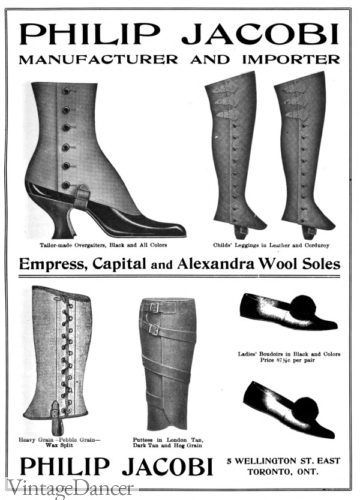
1909 spats, leggings and puttees
Edwardian Sneakers
You may be surprised to learn that Edwardian women played some sports with specialty shoes we now call sneakers or trainers. Early sneakers were the same as men’s, with a leather body and flat leather sole. They had matching leather laces to tie them up.
These gym shoes or bowling shoes were designed for indoor sports and exercise. They also came in a high top version but only in men’s sizes until the 1910s.
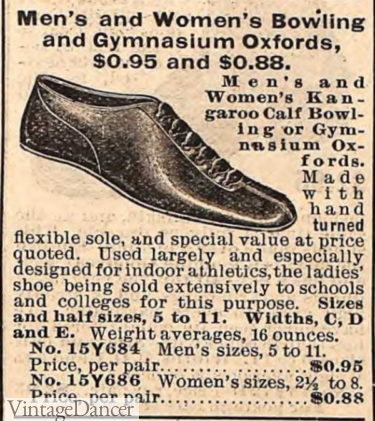
1904 black leather gym shoes
Shoes for lawn sports such as tennis were similar to gym shoes but with a rubber sole. They also came in duck cloth (canvas) for greater flexibility and both high top and low top for support. They resembled Keds Champion shoes still made today.

1915 sport shoes, canvas cloth with rubber soles
All leather oxford shoes with a flat or very low heel were popular outdoor sport shoes such as walking, hiking, boating, golf and tennis. White duck cloth or kid leather was preferred for tennis and sailing/yachting. Rubber soles provided more traction on smooth surfaces. Leather soles were better for rugged sports.
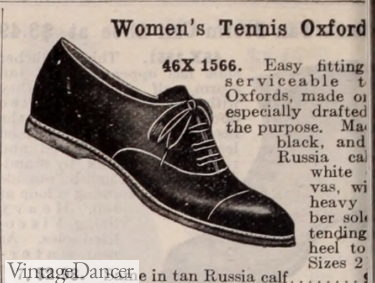
1908 black oxford style tennis shoes
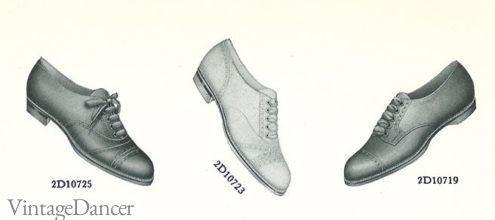
1913 leather hiking, yachting, tennis oxford shoes
Edwardian Sandals
Barefoot sandals were a children’s summer shoe. Made of tan leather or white canvas they covered most of the foot with a few cutouts near the toes center with a T strap. Young women began wearing hem too, usually in costal or lake towns.
Because they were intended to be worn barefoot, women found them scandalous or liberating, depending one ones social status. Modest minded women may have still worn them with stockings, just like they did from swimming.
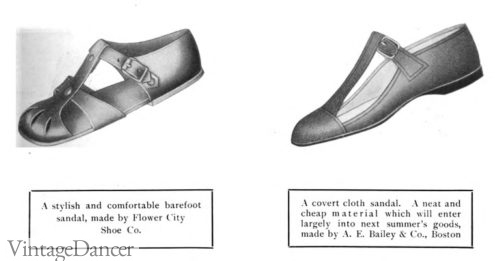
1904 barefoot sandals in leather and canvas
Bathing slippers were like gym shoes with thin rubber soles and a white or black canvas body that tied with 1-2 laces.
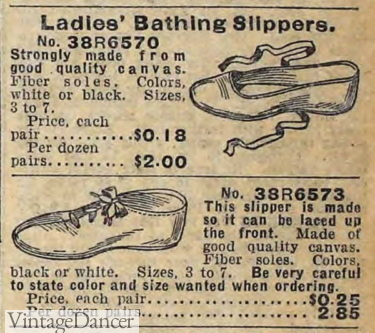
1909 bathing slippers
Edwardian Bedroom Shoes
Slippers also were named bedroom shoes or boudoir slippers when worn in the home only. A basic slip on Romeo style came in felt, leather, a warm cloth or “carpet,” a tapestry weave. They were often handmade from crochet yarn in cheerful colors: pink, red, blue, black, or purple.
- 1904 carpet slippers
- 1909 crochet slpipers
Plaid cloth slippers trended towards the 1910s. They could be the Romeo shape, a bootie with a fold down cuff or a taller bootie with small buckle.
Others fabric slippers had embroidered designs on the vamp or all over the foot.
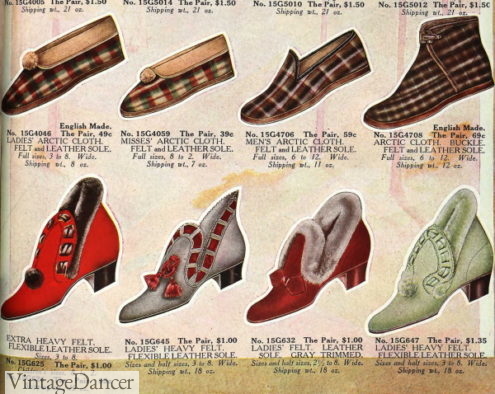
1911 house slippers and Juliet boots
Flat slippers were not as common as another style called Nullifiers.
Nullifier slippers – A shoe with high vamp and quarter, dropping low at the sides, made with a leather or rubber goring for house wear looed like carriage boots with fur trim.
They changed to the name Juliet slipper around 1910. Nullifers were elegant and richly made up in silk, satin, velvet, felt, or smooth leather and lined for warmth. Trimming could be pom poms, tassels, wide ribbons, and fur. They came in bright colors- red, pink, violet and green. I want a pair!
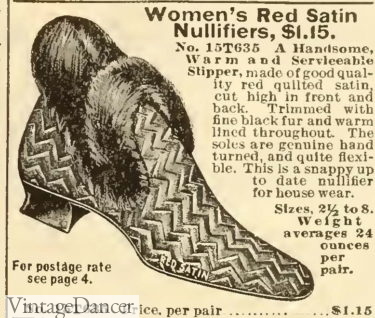
1902 slippers or carriage boots called Nullifiers
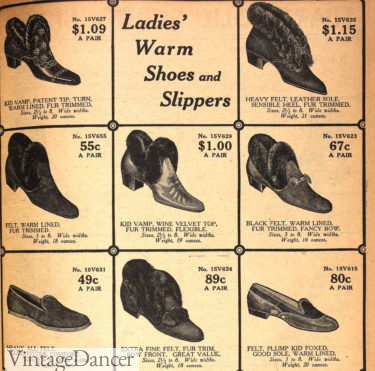
1910 nullifiers / slippers
Moving into the 1910s flat slippers added more decorations such as the pom pom bow, moccasin motifs, and ribbon trim.
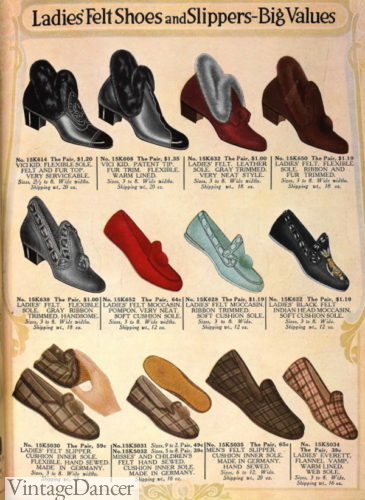
1912 slippers
Boudoir slippers for the upper classes who put on tea gowns to lounge in before dinner were much more elegant than bedroom slippers. They resembled evening pumps but could also be mules. Made of silk or satin and richly embroidered in flowers, beading, and ribbon work with a very thing leather sole and curved Louis heel they were soft, flexible and oh so pretty.
Watch how to make Boudoir slippers by Vicky D’Incecco
What other styles of Edwardian shoes do you want to know about?
Sources:
A variety of Sears, Macys, and similar catalogs from the 1900s and 190s provided the bulk of the images and history. Shoe industry magazines such as the Boot and Shoe Recorder, The Shoe Retailer, and Shoe Retailer and Boots and Shoes Weekly were also very helpful.
See more fashion history books I reference here.
All rights reserved. Copyright protected.
Debbie Sessions has been teaching fashion history and helping people dress for vintage themed events since 2009. She has turned a hobby into VintageDancer.com with hundreds of well researched articles and hand picked links to vintage inspired clothing online. She aims to make dressing accurately (or not) an affordable option for all. Oh, and she dances too.
